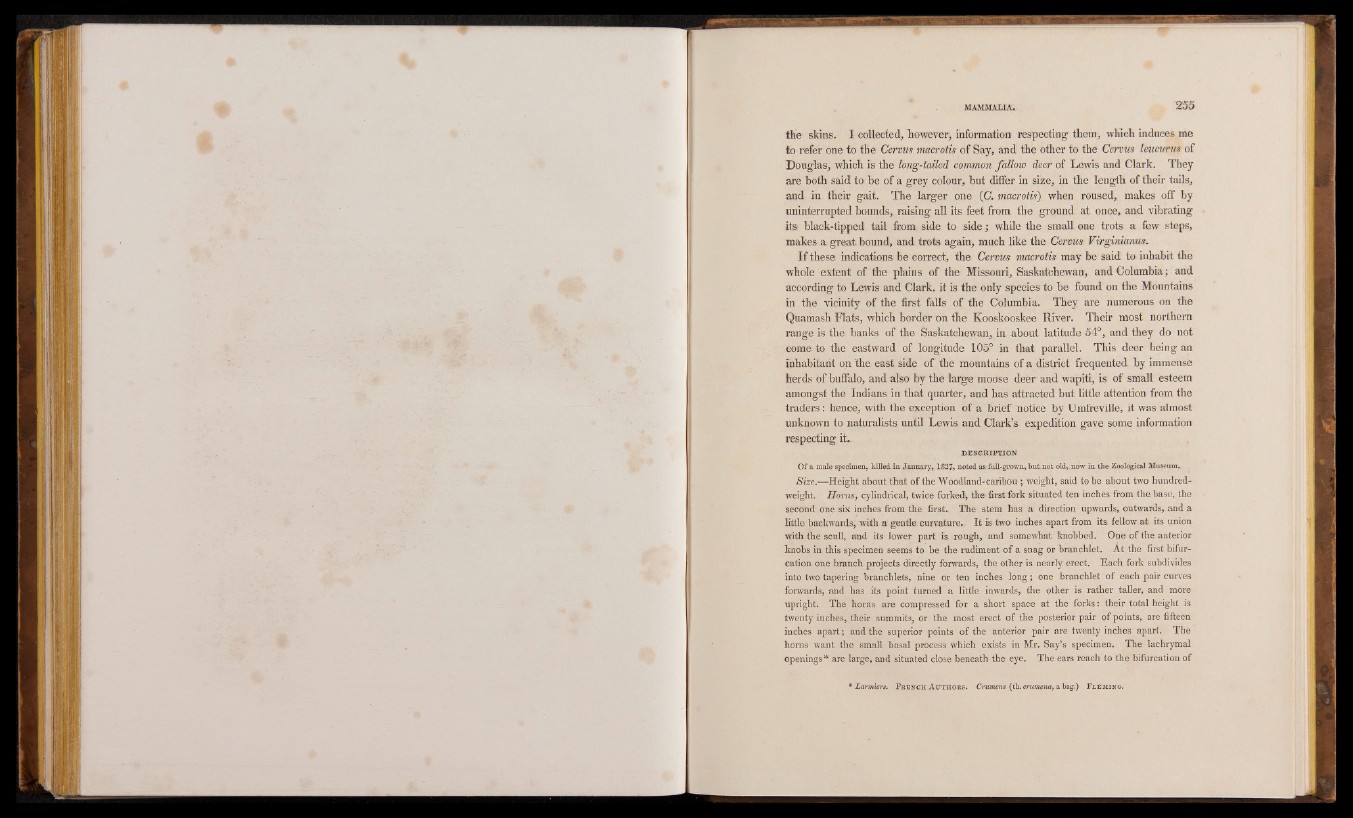
the shins. I collected, however, information respecting them, which induces me
to refer one to the Germs macrotis of Say, and the other to the Genus leucurus of
Douglas, which is the long-tailed common fallow deer of Lewis and Clark. They
are both said to be of a grey colour, but differ in size, in the length of their tails,
and in their gait. The larger one (G. macrotis) when roused, makes off by
uninterrupted bounds, raising all its feet from the ground at once, and vibrating
its black-tipped tail from side to side; while the small one trots a few steps,
makes a great bound, and trots again, much like the Germs Virginianus.
If these indications be correct, the Germs macrotis may be said to inhabit the
whole extent of the plains of the Missouri, Saskatchewan, and Columbia; and
according to Lewis and Clark, it is the only species to be found on the Mountains
in the vicinity of the first falls of the Columbia. They are numerous on the
Quamash Flats, which border on the Kooskooskee River. Their most northern
range is the banks of the Saskatchewan, in about latitude 54°, and they do not
come to the eastward of longitude 105° in that parallel. This deer being an
inhabitant on 'the east side of the mountains of a district frequented by immense
herds of buffalo, and also by the large moose deer and wapiti, is of small esteem
amongst the Indians in that quarter, and has attracted but little attention from the
traders: hence, with the exception of a brief notice by Umfreville, it was almost
unknown to naturalists until Lewis and Clark’s expedition gave some information
respecting it..
D E S C R IP T IO N
Of a male specimen, killed in January, 1827, noted as full-grown, but. not old, now in the Zoological Museum.,
Size.—Height about that of the Woodland-caribou ; weight, said to be about two hundredweight.
Horns, cylindrical, twice forked^ the first fork situated ten inches from the base, the
second one six inches from the first- The stem has a direction upwards,, outwards, and a
little backwards, with a gentle curvature. It is two inches apart from its fellow at its union
with the sCull, and its lowet part is rough, and somewhat knobbed. One of the anterior
knobs in this specimen seems to be the rudiment of a snag or branchlet. At the first bifurcation
one branch projects directly forwards, the other is nearly erect. Each fork subdivides
into two tapering branchlets, nine or ten inches l o n g o n e branchlet of each pair curves
forwards, and has its point turned a little inwards, the other is rather taller, and more
upright. The horns are compressed for a short space at the forks: their total height is
twenty inches, their summits, or the most erect of the posterior pair of points, are fifteen
inches apart; and the superior points of the anterior pair are twenty inches apart. The
horns want the small basal process which exists in Mr. Say’s specimen. The lachrymal
openings * are large, and situated close beneath the eye. The ears reach to the bifurcation of
Larmiers. F r e n c h A u t h o r s . Crumens ( th . emmena, a b a g .) F l e m in g .